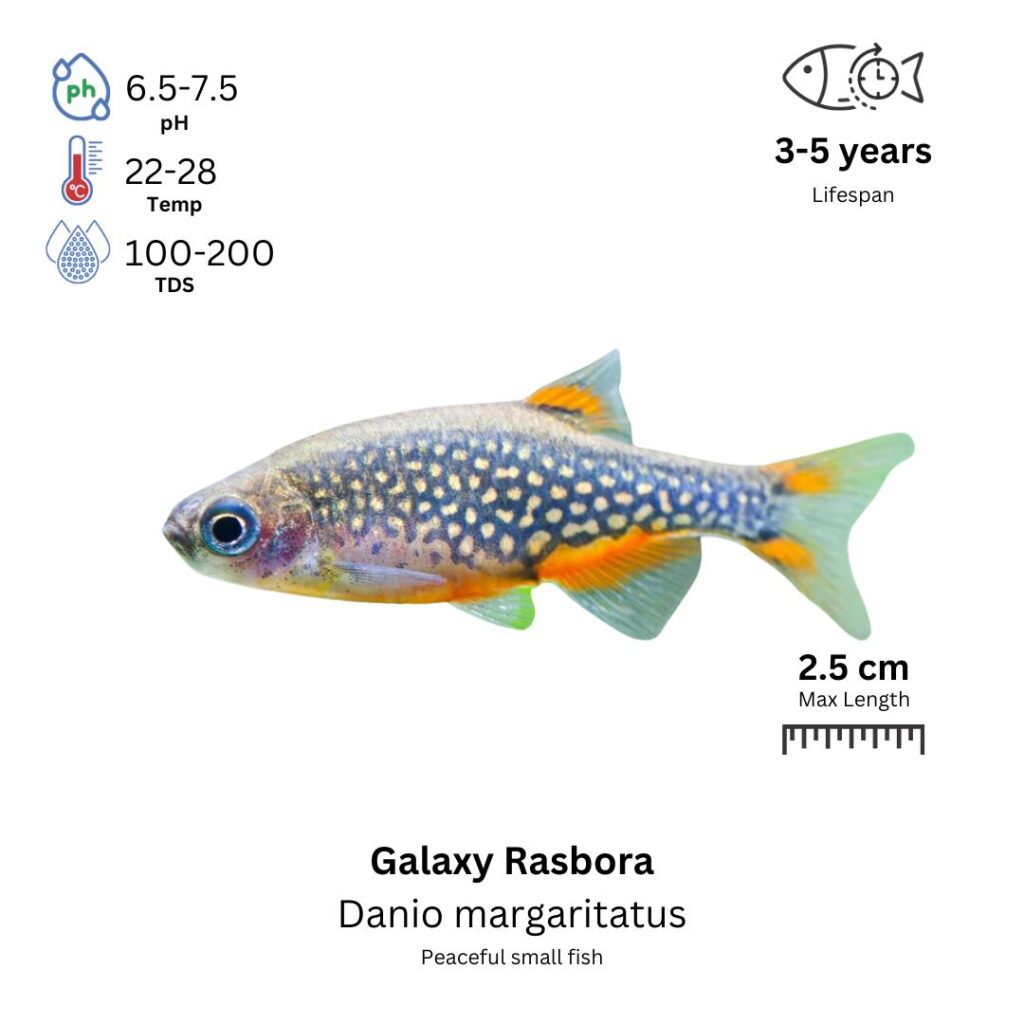Galaxy Rasbora
Danio margaritatus

Description
The Galaxy Rasbora, also known as the Celestial Pearl Danio, is a small but stunning fish known for its vibrant coloration. Its body is a deep blue with tiny white spots, resembling a starry sky, giving it the “galaxy” look. The tail and fins are typically a mix of reddish-orange hues, which complement the sparkling pattern on its body. These fish are peaceful and active, preferring to swim in groups and often darting through the mid-levels of the tank. Their small size and vibrant colors make them a popular choice for aquariums, especially in aquascapes or nano tanks.
Habitat Origin
Native to the clear, slow-moving streams in Myanmar (Burma), where they are found in areas with dense vegetation and submerged rocks.
Aquarium
Ideal Number in Aquarium: At least 6-8 individuals, as they are schooling fish and thrive in groups.
Favorite Food

Galaxy Rasboras are omnivores and will accept a wide variety of foods, including high-quality flake food, micro pellets, live or frozen foods such as daphnia, brine shrimp, and bloodworms. They also enjoy algae-based foods and finely chopped vegetables like spinach or zucchini.
Behavior:
Galaxy Rasboras are peaceful, gentle fish that do well in community tanks with other small, peaceful species. They are active and curious but are not aggressive, making them ideal for aquascaped tanks with other similar-sized fish. They are schooling fish and feel safest when kept in groups, often swimming together in the middle and upper regions of the tank. While they are peaceful, they may become timid if kept in smaller numbers or with larger, more aggressive fish.
Special Care:
These fish do best in a well-maintained, planted tank with plenty of hiding spots. A gentle water flow and stable water parameters are crucial, as they are sensitive to poor water quality. They also prefer tanks with good filtration and regular water changes. They are small, so be careful with tankmates that may harass them.
Compatibility with Other Fish:
Yes, they are well-suited for peaceful community tanks, particularly with other small, non-aggressive species such as tetras, rasboras, and shrimp. They should be avoided with larger, more aggressive fish that may bully them or view them as food. Due to their small size, tankmates should be selected with care to avoid any risk of predation.
Breeding Tank Setup
A dedicated breeding tank is essential for Galaxy Rasboras, as eggs and fry are highly vulnerable in community setups. A 5-gallon tank (19 liters) is sufficient for a small breeding group, while a 10-gallon tank (38 liters) is better for multiple pairs. Maintain pH 5.5–7.0, temperature 24–28°C (75–82°F), and hardness 2–8 dGH. Use a sponge filter or a small internal filter to provide clean water without disturbing flow. Avoid substrate or use fine gravel to prevent eggs from falling into hard-to-reach areas. Add soft-leaved plants like Java moss, Java fern, or Anubias as spawning surfaces, and include floating plants like Water Sprite or Hornwort to provide shade and shelter. Set up moderate lighting with a 12-hour light cycle to simulate natural conditions.
Conditioning the Breeders
Condition your Galaxy Rasboras with a balanced, protein-rich diet. Offer high-quality flakes or micro pellets, and supplement with live or frozen foods such as brine shrimp, daphnia, and microworms. Include vegetable-based items like blanched peas or spinach to support digestive health. Perform weekly water changes (20–30%), and to stimulate breeding, carry out a larger water change (~50%) with slightly warmer water—this mimics seasonal rainfall and can trigger spawning behavior.
Spawning Behavior
Spawning generally occurs in the early morning hours, especially after environmental changes. Males become more colorful and chase females in a brief courtship. Females scatter 20–30 small, sticky eggs across plants and tank surfaces. Once spawning concludes, remove the adults immediately to prevent them from eating the eggs. The sticky eggs will adhere to leaves and surfaces, where they can safely develop in the absence of predation.
Fry Development
Eggs hatch within 24–48 hours, depending on temperature. Newly hatched fry will feed on their yolk sacs for the first few days. Begin feeding with infusoria or liquid fry food, then transition to baby brine shrimp or microworms as the fry grow. The tank should have biofilm-rich surfaces for additional grazing. Maintain stable temperature and perform small daily water changes (10–20%) to ensure clean water. Avoid overfeeding, as decaying food can quickly compromise water quality.
Breeding Tips
Galaxy Rasboras are sexually mature at 6–8 months, but breeding is more consistent with healthy adults around 1 year old. Males are slimmer and more vibrant, showing red-orange coloration during breeding, while females are larger and rounder, especially when carrying eggs. Avoid any sudden shifts in water conditions, and keep the breeding tank peaceful and free from stressors such as aggressive or territorial fish. Stable, soft water and a calm environment are key to a successful breeding experience.
